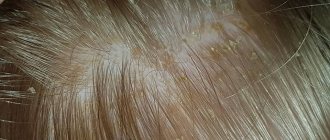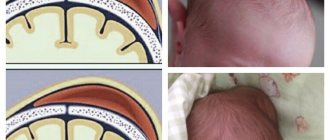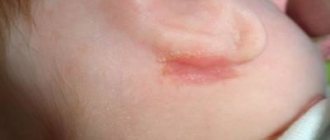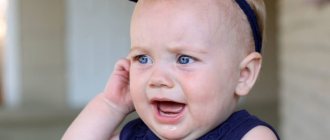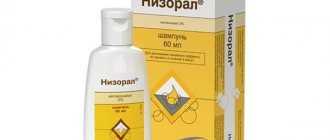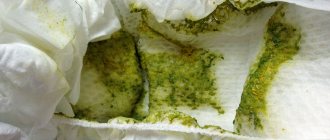The hairstyle of babies in their first year of life undergoes a number of changes. As a rule, a child is born hairy. Then, fluff-like hairs roll out, especially in places where the head comes into contact with the mother's hand during feeding. Hair may change color and grows very slowly.
You can also find yellowish spots on the baby’s head that are not very pleasant to look at. In medicine, a similar phenomenon is called gneiss in newborns, lep, seborrheic or milk crusts. We'll talk about them.
What is gneiss
Gneiss occurs in children in the first months of life, and is familiar to almost every family with children. Areas appear on the baby's head that look like accumulations of dandruff, or scales with a color range from yellow to grayish. Islands of gneiss can be either small or grow, covering the head like a cap. Sometimes the crusts spread to other parts of the body: behind the ears, on the neck, eyebrows.
Gneiss usually appears in the first month of life, and some children are already born as such. But by the age of 6 months, in almost all cases, not a trace remains of the crusts.
Gneiss in a newborn is not a disease, it does not cause pain or suffering to the baby, for the most part it does not require special treatment and can be removed simply, but not in one go. Where does it come from?
Causes
There is an opinion that the baby's scabs appear due to breastfeeding, and when the mother stops breastfeeding, they disappear. That is why such crusts are called milk crusts. But this is a myth. There is no connection between gneiss and breastfeeding.
Although gneiss is not a disease, it looks unaesthetic, so parents try to get rid of it
Seborrheic crusts are called not because they indicate a disease, but because the forming scales are similar in appearance to those that form with seborrheic dermatitis.
The main cause of gneiss is hyperfunction of the sebaceous glands. In a baby, many organs and systems operate in “tuning” mode. Firstly, the hormonal background fails, which changes somewhat after birth. Secondly, the sweat and sebaceous glands have not yet learned to cope with their tasks, so scales form on the head as a result of excess sebum secretion. There are other factors that can aggravate this condition.
Caring for a crust on a baby's head
Processing of crusts includes the following 3 stages, shown in the table below: softening, bathing and combing.
The main stages of caring for seborrheic crusts:
| p/p | Name | Description of action |
| 1 | Softening | Using oils that are suitable for the baby, you must first soften the crusts on the baby’s head. The oil should be applied approximately 55-60 minutes before bathing. In order for the crusts to soften as best as possible, you need to put a knitted cap on the baby. Before bathing, lightly massage the baby's head with a soft massage brush. It is correct to use a brush with natural bristles. |
| 2 | Bathing | You should bathe your baby with a special mild shampoo consisting of natural ingredients. After finishing bathing, you do not need to rub your baby with a towel, this may cause him discomfort. It is better to gently pat your scalp, body and hair dry with a soft towel. |
| 3 | Combing |
|
What enhances the formation of gneiss?
We recommend reading: Why the skin of newborns peels
- Tendency to allergies. When a child is prone to diathesis and other manifestations of allergies, his immunity is weaker than usual. Therefore, crusts on the head may not go away for a long time.
- Overheat. Imperfect thermoregulation is not able to withstand overheating of the skin, and the heat exchange process is more difficult. It is especially bad when a child wears a cap for 24 hours in the summer. There is no need to cover the baby's head if you are at home or outside, it is hot, accompanied by a slight breeze.
- Frequent washing. If you are a supporter of washing your baby’s hair every day with all kinds of shampoos, then know that in this way you are more likely to dry out the baby’s delicate skin, which only mobilizes the work of the sebaceous glands, and the crusts grow more intensely.
- Unsuitable hygiene products. Not all shampoos and foams for washing hair are suitable for your baby, even if they are marked “from birth” or “hypoallergenic”. And remember, even if the product is suitable, the baby’s head is washed once, maximum twice a week.
Is gneiss a disease?
There is no need to blame a young mother for careless care of her baby. Gneiss is a physiological phenomenon, the causes of which lie in the imperfect functioning of the sebaceous and sweat glands, or more precisely, in their disharmonious work.
It may not go away for a long time if the child’s scalp is not properly cared for and there is a tendency to allergic reactions.
Typically, gneiss on the scalp is most noticeable on the crown, in the fontanelle area, and may even be on the baby’s forehead and eyebrows. The child’s mother, frightened by such a sight and the belief of some people that her child’s hair will not grow, can, of course, immediately go for a consultation with a pediatrician. However, before visiting a doctor, you can try to figure out the causes of the nasty lep yourself.
Looking for reasons
1. For excessive fear of drafts and hypothermia, parents put a hat on their baby, even at home. This leads to even more sweating of the head and the appearance of more and more milky crusts.
2. The baby’s delicate skin is quite vulnerable. Cosmetics containing fragrances and dyes can also provoke various skin reactions. It is necessary to avoid cosmetics with bright colors and strong odors. And of course, never use shampoos for adults.
3. Daily water procedures with washing your hair will most likely lead to dry scalp. As a result, the work of the sebaceous glands will intensify, and the number of yellow crusts will only increase.
4. Strange as it may sound, the cause of the appearance of gneiss may also be the introduction of complementary foods. Mostly, such reactions occur in children prone to allergies.
Having analyzed the correctness of caring for the baby, and having understood your mistakes, it is still worth starting to rid the small head of unnecessary layers. You shouldn’t wait for the gneiss on your head and eyebrows to go away on its own. Lack of proper scalp care can lead to prolonged seborrhea and the child’s crusts will remain until the age of 4 or even 7 years and will require consultation with a dermatologist. With proper care, the dark crusts gradually disappear by the second year of the baby’s life.
You should not use drastic methods of removing the crust, trying to pick and rip off the scales using nails or other objects. This can injure the delicate skin, causing a lot of anxiety for the baby.
How to get rid of crusts
What happens if the baby's gneiss is not touched? Actually, it's okay. The time will come, and the crusts will disappear on their own (unless, of course, there are allergic problems). But few parents are ready to look at them every day. Purely for aesthetic purposes, most people strive to get rid of gneiss as quickly as possible. Well, it is quite possible to speed up the process, but you need to do it correctly.
Combing correctly
In order to comb out the leopard, purchase a special comb with natural bristles and a plastic comb with blunt, fine teeth from the pharmacy. On the day when you plan to bathe and wash your hair, the scalp is lubricated with oil 40-60 minutes before water procedures, and a cotton cap is put on.
Pharmacies sell special combs for combing out hair.
Immediately before bathing, the cap is removed and the scalp is massaged using fingertips or a comb with natural bristles.
Pharmaceutical companies have developed a lot of cosmetic products aimed at combating gneiss.
It is forbidden to pick out crusts with your nails, especially “dry”. Such manipulations are fraught with the formation of wounds with possible infection. All this causes discomfort to the baby.
Let's start with water procedures. Lather your hair with baby shampoo, massage again, and then carefully rinse. We blot the hair with a towel and begin to comb it first with a comb and then with a brush. To save money, the comb can be replaced with gauze folded in several layers.
There are special creams for seborrheic crusts, for example, Mustela Stelaker or cream from the Uriage series. Their action is approximately the same. At night, the cream is applied to the scabs, they soften, and in the morning the hair is washed with shampoo and combed. Manufacturers promise to get rid of gneiss in one day. In practice, softening occurs, but several sessions are necessary.
You should not try to get rid of gneiss in one go. All actions aimed at eliminating them must be carried out delicately, slowly, avoiding injury to the delicate baby skin.
What to do with a crust on a baby’s head
There is no clear answer to this question. The opinions of doctors are divided: there are supporters of the mandatory removal of crusts from the baby’s head, as well as those who believe that nothing needs to be done with such manifestations of seborrheic dermatitis.
The time will come, and they themselves will gradually disappear.
Shampoo for crusts on baby's scalp
Special shampoos are available to get rid of crusts, but they are produced only by some manufacturers. The effect of removing crusts from using a special shampoo is highly individual.
For some children, a few uses are enough, while the parents of other children do not observe the effect for several months.
The set of shampoo components for the treatment of seborrheic dermatitis includes:
- various cosmetic oils with a “softening” effect;
- antiseptic, such as salicylic acid;
- extracts of medicinal plants and flower extracts;
- panthenol, ensures rapid tissue restoration.
The point of using shampoo is that it contains softening and moisturizing ingredients. The shampoo is applied to the head, foamed and left for 2-3 minutes. Then you need to wash it off and start combing out the crusts that have peeled off from the skin. As a result, the crusts become soft and pliable and are easy to comb out.
You should buy shampoo either in pharmacies or in trusted stores, paying attention to the expiration date. The reliability and safety of the shampoo is indicated by the presence of a quality certificate, for example, ORGANIC, NATURE, COSMOS.
To combat crusts on a baby’s head, the following cosmetics are suitable:
- “La-Cri” is available in the form of foam and the active ingredient is sorbic acid;
- "Mustela" not only ensures the removal of seborrheic dermatitis scales, but also prevents the formation of new ones;
- "Babe Laboratorios" contains undecylenic acid, which can destroy bacteria and prevent fungi from developing;
- “My Baby” is a special product for removing milk crusts in children;
- HiPP Babysanft is a very soft and gentle product for babies without alkalis.
Oil for seborrheic crusts
An effective way to remove seborrheic crusts on a baby’s head is also to use various oils, for example:
- peach;
- jojoba;
- burdock;
- almond;
- olive;
- tea tree.
Thus, almost any vegetable oil will do, mainly sterile or boiled.
After consulting with a pediatrician, you can try special oils from manufacturers of children's cosmetics, such as Vavu Born oil, designed to combat milk crusts.
Preventive measures
What else will help get rid of milk crusts faster? Here are some recommendations:
- Give your skin a chance to breathe. Spending some time naked is very beneficial. Do not overuse the wearing of caps and caps unless necessary.
- Reduce the room temperature. Everyone knows that to maintain health, the optimal temperature in a children's room should be close to 20 OC, and humidity levels should be kept at approximately 60-70%. Modern devices such as air conditioners and humidifiers can become your faithful assistants if used correctly.
- For children - children's cosmetics. Don't try to save money on baby shampoo. Subsequently, you can spend a lot more money on treating allergic diseases.
If there is no direct sunlight during a walk on a summer morning, do you need to wear a cap every time?
When you need a doctor's help
If the gneiss stubbornly does not go away, look for the reason. It could be a fungal infection or atopic dermatitis. Review your diet if you are breastfeeding.
You should definitely consult a doctor if you have the following signs:
- within a week of trying to get rid of gneiss there are no changes;
- the child tries to scratch the scabs and becomes irritable;
- scales become wet;
- crusts grow;
- the scales peel off and spread throughout the body.
As you can see, gneiss in newborns is not as terrible as it seems at first. It is associated with the physiological characteristics of the infant period and passes without a trace over time. But sometimes you need to consult a doctor so as not to miss a disease that can masquerade as milk crusts.

